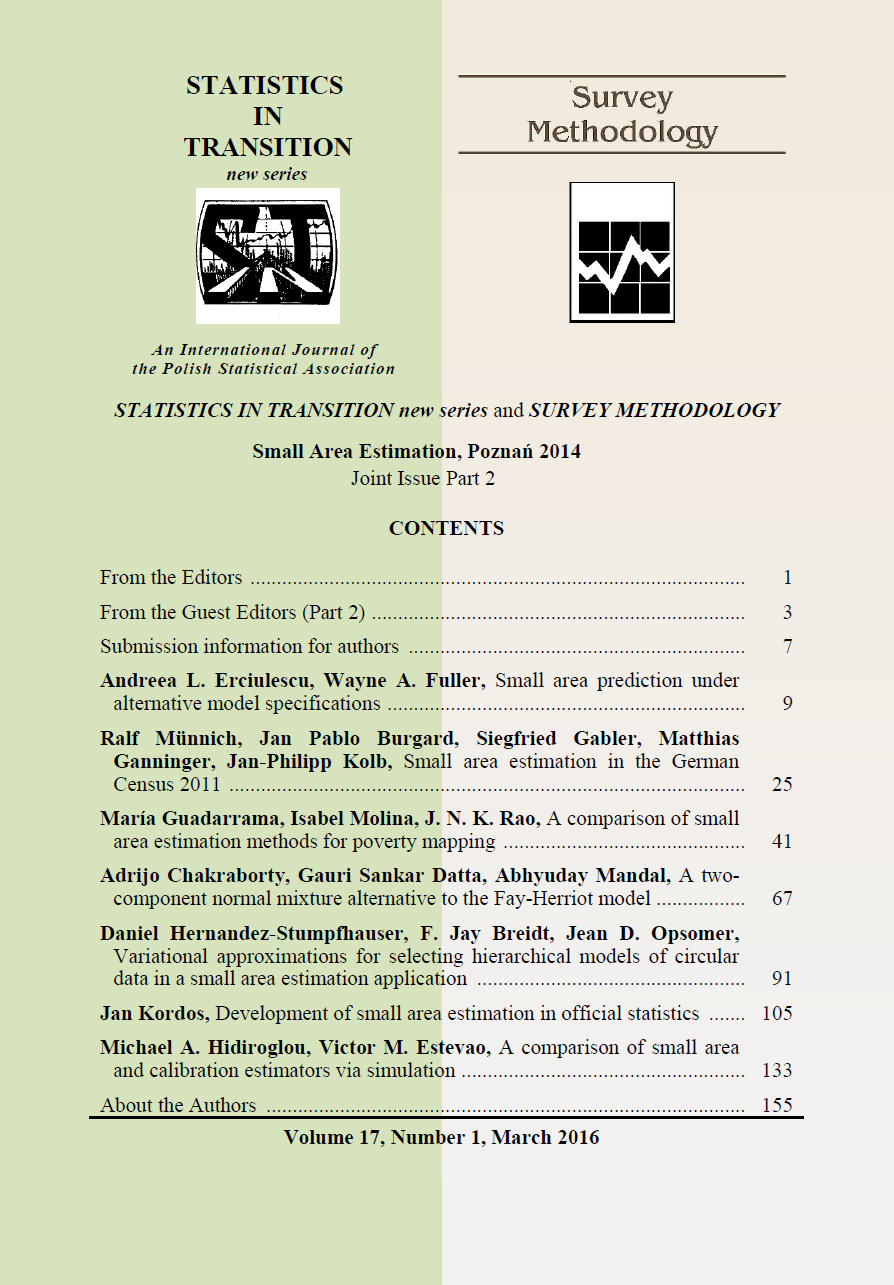ARTICLE
ABSTRACT
Domain estimates are typically obtained using calibration estimators that are direct or modified direct. They are direct if they strictly use data within the domain of interest. They are modified direct if they use both data within and outside the domain of interest. An alternative way of producing these estimates is through small area procedures. In this article, we compare the performance of these two approaches via a simulation. The population is generated using a hierarchical model that includes both area effects and unit level random errors. The population is made up of mutually exclusive domains of different sizes, ranging from a small number of units to a large number of units. We select many independent simple random samples of fixed size from the population and compute various estimates for each sample using the available auxiliary information. The estimates computed for the simulation included the Horvitz-Thompson estimator, the synthetic estimator (indirect estimate), calibration estimators, and unit level based estimators (small area estimate). The performance of these estimators is summarized based on their design- based properties.
KEYWORDS
area level, unit level, calibration estimates, small area estimates, simulation
REFERENCES
BATTESE, G. E., HARTER, R. M., FULLER, W. A., (1988). An error component model for prediction of county crop areas using survey and satellite data. Journal of the American Statistical Association, 83 (401), 28–36.
DATTA, G. S., (2009). Model-based approach to small area estimation. Handbook of Statistics, 29, 251–288.
DEVILLE, J. C., SÄRNDAL, C. E., (1992). Calibration estimation in survey sampling. Journal of the American Statistical Association, 87(418), 376–382.
ESTEVAO, V., HIDIROGLOU, M. A., YOU, Y., (2014). Methodology Software Library - Small area Estimation Methodology Specifications for Area and Unit Level based Models. Technical Report, Statistics Canada.
FAY, R. E., HERRIOT, R. A., (1979). Estimation of income for small places: an application of James-Stein procedures to census data. Journal of the American Statistical Association, 74 (366A), 269–277.
LEHTONEN, R., VEIJANEN, A., (2009). Design-based methods of estimation for domains and small areas. Handbook of statistics, 29, 219–249.
PFEFFERMANN, D., (2013). New important developments in small area estimation. Statistical Science, 28(1), 40–68.
PFEFFERMANN, D., SVERCHKOV, M., (2007). Small Area Estimation Under Informative Probability Sampling of Areas and Within the Selected Areas. Journal of the American Statistical Association 102 (480), 1427–1439.
RAO, J. N. K., (2003). Small Area Estimation: John Wiley & Sons.
SINGH, A. C., MIAN, I. U. H., (1995). Generalized Sample Size Dependent Estimators for Small Areas, Proceedings of the 1995 Annual Research Conference, U.S. Bureau of the Census, Washington, DC, 687–701.
SINGH, M. P., GAMBINO, J., MANTEL, H., (1994). Issues and Strategies for Small Area Data. Survey Methodology, 20 (1), 3–22.
WOODRUFF, R. S., (1966). Use of a Regression Technique to Produce Area Breakdowns of the Monthly National Estimates of Retail Trade. Journal of the American Statistical Association, 61 (314), 496–504.
YOU, Y., RAO, J. N. K., (2002). A pseudo-empirical best linear unbiased prediction approach to small area estimation using survey weights, Canadian Journal of Statistics, 30, 431–439.
VERRET, F., RAO, J. N. K., VERRET, F., RAO, J. N. K., HIDIROGLOU, M. A.,(2015). Model-based small area estimation under informative sampling. To appear in the December 2015 issue of Survey Methodology.
